Menu
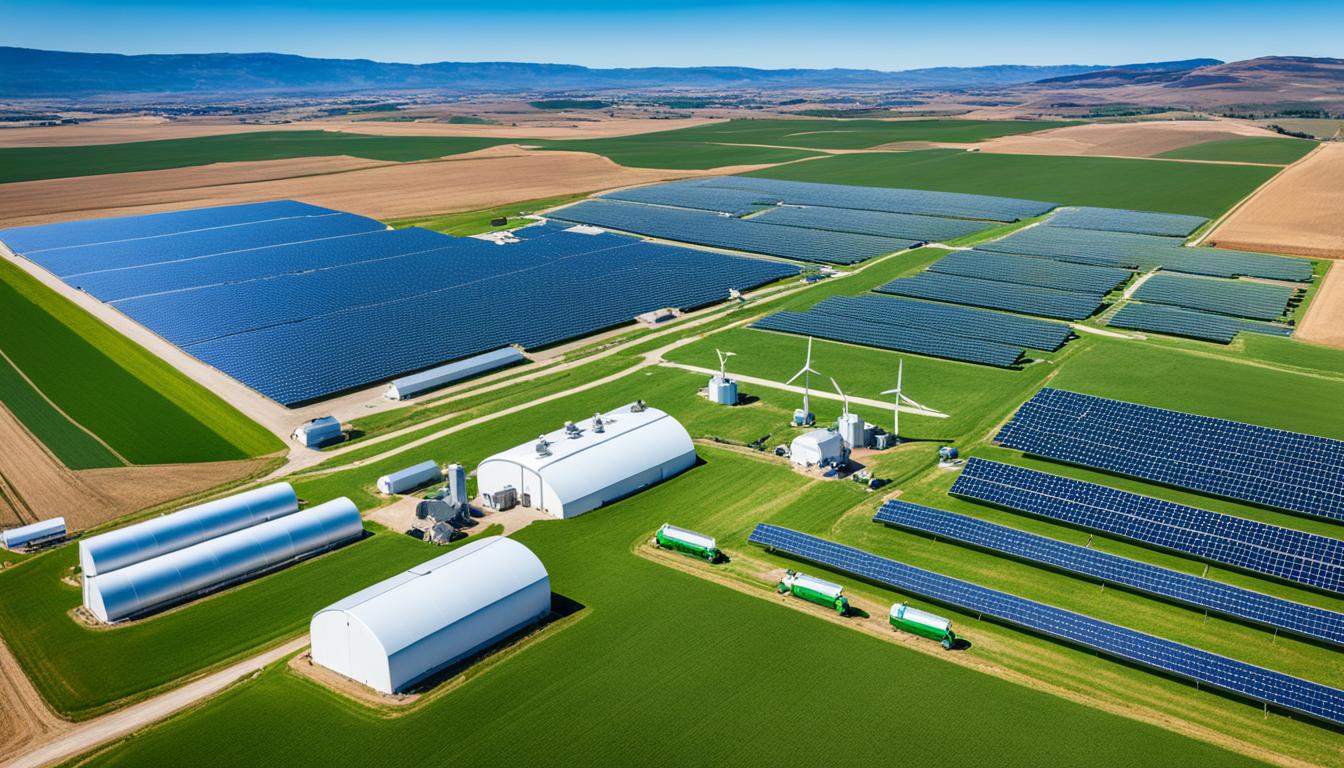
At the end of 2005, wind energy provided 9,149 MW of power across 30 U.S. states. Looking ahead, the International Energy Agency (IEA) predicts a 50% growth in renewables by 2024. This increase will be mainly due to more solar power.
Today, more solar, wind, and hydropower projects are appearing faster than ever. This shows that the future of green energy is bright. The costs of these technologies have fallen. Also, the need to protect our planet is pushing us to use more renewable energy.
By 2024, we expect to have a lot more solar power – 600 gigawatts more, to be exact. This progress shows how important new ideas and technology are for creating energy on farms.
Renewable energy farming is key in fighting climate change and achieving sustainability. It uses solar, wind, and biofuels for farm work. This helps cut down on greenhouse gas emissions and improves energy security. It’s all about farming in an eco-friendly way.
Renewable energy farming means using clean energy on farms. Solar power is a common choice, bringing down energy costs. Wind power, especially in windy areas, lets farms store extra energy or sell it back. Also, biofuels like biodiesel and ethanol offer green options. They cut the use of fossil fuels and lower costs for farmers.
Farming’s switch to renewable energy is a big change. In the past, 26% of global electricity came from renewable sources. But with more investments and progress, this number is rising. Big farms now use solar or wind power for their needs, thanks to programs like REAP and USDA’s Bioenergy Program.
These schemes offer help like the Investment Tax Credit for solar. It cuts taxes and makes green energy cheaper. Also, many states give out rebates and grants for eco-projects. This makes renewable energy a strong choice for farmers.
Since 2002, many federal incentives from the Farm Bill have pushed for more renewable systems. This not only helps the planet but also boosts the economy. Wind power, for example, can lead to 80,000 new jobs and $1.2 billion in extra income. These moves show the value of green energy in farming.
Farming is moving towards a more sustainable path with the use of renewable energy. Tapping into sources like solar, wind, and biofuels, farmers are powering their operations. This shift helps cut costs and reduces their reliance on traditional energy methods.
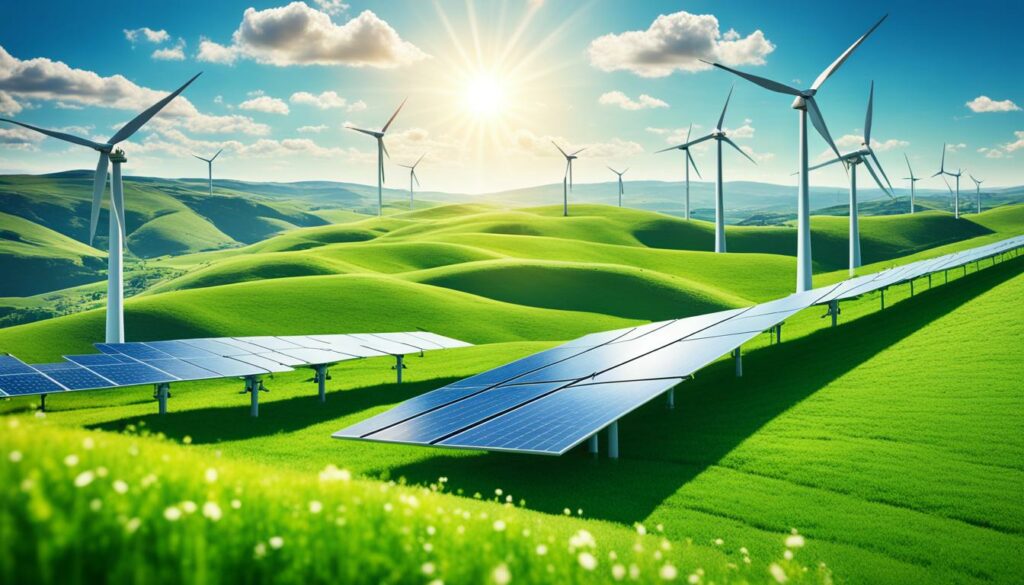
In several places, solar power is winning the race in the renewable energy adoption. Countries like the US, the UK, and Australia are making great progress. For example, the US plans to hit four million solar installations by 2023. In 2018, the UK passed the one million mark, and Australia hit two million. The cost of solar energy is also going down, making it more attractive.
Global leaders, governments, and tech companies are driving the change. They’re pushing regulations and offering financial help to switch to solar. Programs like REAP and ITC are big helpers, offering grants and tax breaks for solar adoption. This support is encouraging more farms to make the change.
Big tech companies are also pushing things forward. Their advancements are making it easier to use renewable energy on farms. China, for instance, is a standout in putting up solar panels on homes. It’s evident we’re moving towards cleaner and more sustainable practices, supported by global initiatives.
When governments, companies, and universities work together, big changes happen. And in this case, the farming sector is getting greener. The benefits are not only visible on farms but are also good for the planet.
| Country | Solar Installations | Policy Initiatives |
|---|---|---|
| USA | Projected to double to 4 million by 2023 | ITC, REAP, USDA Bioenergy Program |
| UK | Over one million installations in 2018 | Agriculture Energy Efficiency Rebate programme |
| Australia | Two million installations reached in 2018 | Small Business Advantage Grant (SBAG) |
Farming sustainably is key for the farm’s future and the planet. By using renewable energy, farms can be greener. This cuts the need for fossil fuels and brings in techniques that are good for the Earth.
Bringing in renewable energy can really boost how green a farm is. Thanks to the Inflation Reduction Act, there’s more money for green farming. The Rural Energy for America Program now helps with up to 50% of the costs. Plus, loans combined with this support can give farms up to 75% of the funds needed. Also, federal schemes like the Investment Tax Credit make solar power more affordable. They do this by reducing money taken for taxes by 30% of solar system prices.
Additionally, at a state level, programs offer cashback on farm energy upgrades. This helps a lot in changing to greener farming.
The USDA has its Bioenergy Program to encourage making biofuels sustainably. Then, the EQIP On-Farm Energy Initiative helps farmers get efficient equipment. These kinds of support are vital for making more farming greener.
There are stories that show making farms greener helps the environment and saves money. In California, new buildings need to have solar panels. This shows how practical and profitable solar power can be. Farmers there find they save a lot with solar power because it now costs less.
Worldwide, using renewable energy in farming has big environmental wins. It cuts greenhouse gases and makes the soil healthier. Green farming also helps save water and plants thrive, making the local area richer in life.
about 30% of our energy is used in farming. But, if farms go green, they could save lots of money, become less dependent on others for energy, and deal better with changing energy prices. Green energy systems are also easy to grow as the farm grows.
| Program | Benefit |
|---|---|
| Rural Energy for America Program (REAP) | Funds up to 75% of energy project costs |
| Investment Tax Credit (ITC) | Reduces federal tax liability by up to 30% for solar systems |
| Agriculture Energy Efficiency Rebate | Provides rebates for energy-efficient projects |
| Small Business Advantage Grant (SBAG) | Reimburses costs for energy efficiency improvements |
| Bioenergy Program for Advanced Biofuels | Encourages sustainable biofuel production |
| Environmental Quality Incentives Program (EQIP) | Assists in purchasing energy-efficient equipment |
Renewable energy is changing how farms work. It’s a green and efficient choice over traditional power. The main types used in farms are solar, wind, and hydropower. Each has its own benefits, fitting into farm energy in unique ways.
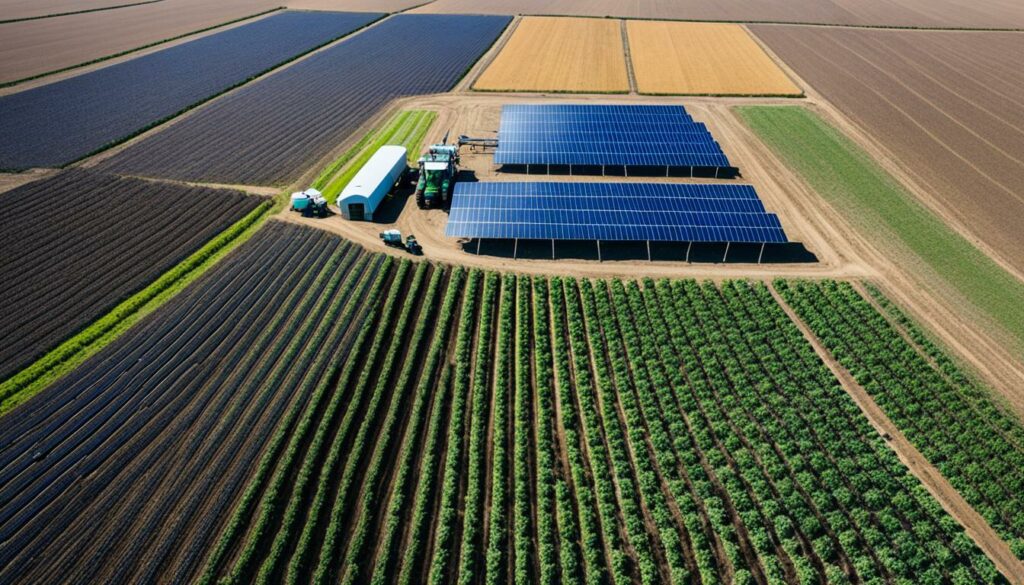
Solar power is a top pick for its easy use and cool tech. It lets farms save money, be less dependent on others, and cut down on dirt in the air. With lots of solar power used in farming already, it’s clearly part of the future of energy for farms.
Wind energy also brings big money and adds jobs. It’s said that by 2020, 80,000 jobs could pop up and $1.2 billion more could be made by farming folk. If a farm has windy spaces, installing wind turbines can earn farm owners $2,000 to $5,000 each year. By 2024, wind and solar power should jump up by nearly 40%, making them key players for future power needs.
Hydropower has been helping farms for a long time, especially where water is plenty. It’s great for making power and watering crops. Yet, setting it up is costly. Even with worries about its effects on society and nature, hydropower is key for keeping farms running smoothly in wet areas.
Solar farming is getting better thanks to new technology. This makes it a good choice for farming in a way that doesn’t harm the environment. It’s important to use these new tools to shape how we make renewable energy.
Solar panels work better now, and there are new kinds, like bifacial ones. We now have solar cells made from perovskite and panels you can see through. Artificial intelligence is even helping to make energy systems smarter. Also, solar tech is being built right into buildings.
Solar energy is becoming cheaper to use. New ways to store energy, such as solar skins and floating farms, help a lot. Because it’s becoming more affordable, more people are choosing solar power for their electricity. Countries are setting big goals to use more solar power.
Big steps are happening thanks to government help. Things like tax breaks and rules that support solar power are making a difference. They encourage people to invest in solar energy. Thanks to these efforts, we’re using less fossil fuel and making more green energy.
Yet, there are still problems like figuring out who can use the land and dealing with other costs. We’re working to solve these issues together. This way, we can have farms that are good for the Earth and use the sun to power them.
The United States wind industry is growing fast. More than 125,000 people now work in it. Wind turbines provided over 10% of the nation’s energy in 2022.
The industry’s quick growth is impressive, fuelled by a $20 billion investment. This money goes into new projects. These projects help avoid 336 million metric tons of carbon dioxide emissions every year.
They also bring in around $2 billion in state and local taxes yearly. Plus, local communities receive payments for using their land.
Despite this success, there are challenges. Adding wind energy to our grids is not easy. But, rural areas with lots of wind are perfect for wind farming. Yet, getting the money and community approval is hard.
Bettering the country’s transmission network could lower wind energy’s costs. This would make getting wind power to more homes easier and cheaper.
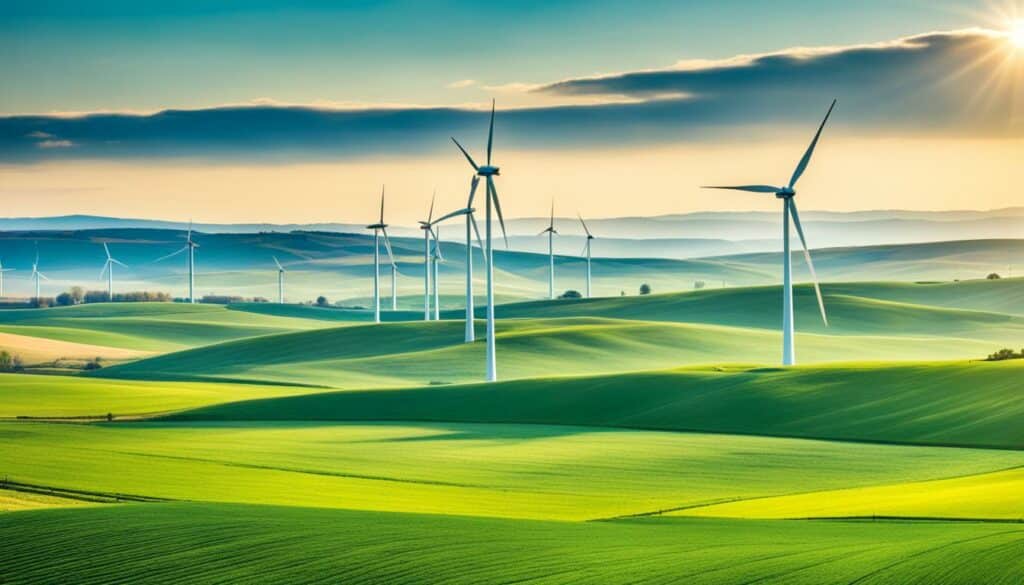
Another issue is how wind farms affect local wildlife. Studies work to fix this problem. Making wind and solar farms cheaper than old energy sources is key. This requires handling zoning rules well.
Advancements are making wind energy cheaper. By 2035, prices could fall by up to 35%. AI and robots will also help. They will cut down costs and increase how green farming is done.
This could make over 6 million new jobs by 2050. Innovations will help wind farming meet its challenges and grow. By working on these problems and using new chances, we can build a better future for green energy in farming.
Hydropower is key for clean energy, making up 31.5% of our renewable electricity and 6.3% of all power. It’s not just good for the earth; it’s also great for farming. Pumped storage systems are very important, making up 93% of big energy storage in the U.S. in the past 10 years. Their growth shows a big future in energy smart farming.
By 2050, U.S. hydropower could jump by 50%, hitting 150 gigawatts. This would be enough to power 35 million homes and save $200 billion in greenhouse gases. Plus, it could create about 200,000 jobs in hydropower. This growth is perfect for making farming more sustainable with better energy use.
Colorado leads in supporting small hydropower projects, showing a good way for other places. In Colorado, 170,000 acres of farmland could produce 30 megawatts of power using water pressure. These small systems can meet the needs of farms and are praised for their affordability and independence.
Colorado also helps landowners and farmers in making small hydropower projects. Laws like Colorado HB14-1030, from May 31, 2014, have made it easier to get permits. Colorado is one of the first states to offer low-cost loans for these projects. This helps spread energy smart farming technology all over the state.
Renewable energy farming will see big changes soon. This growth is thanks to markets, new tech, and rules. Experts at the IEA say solar and wind will expand a lot, good for our planet.
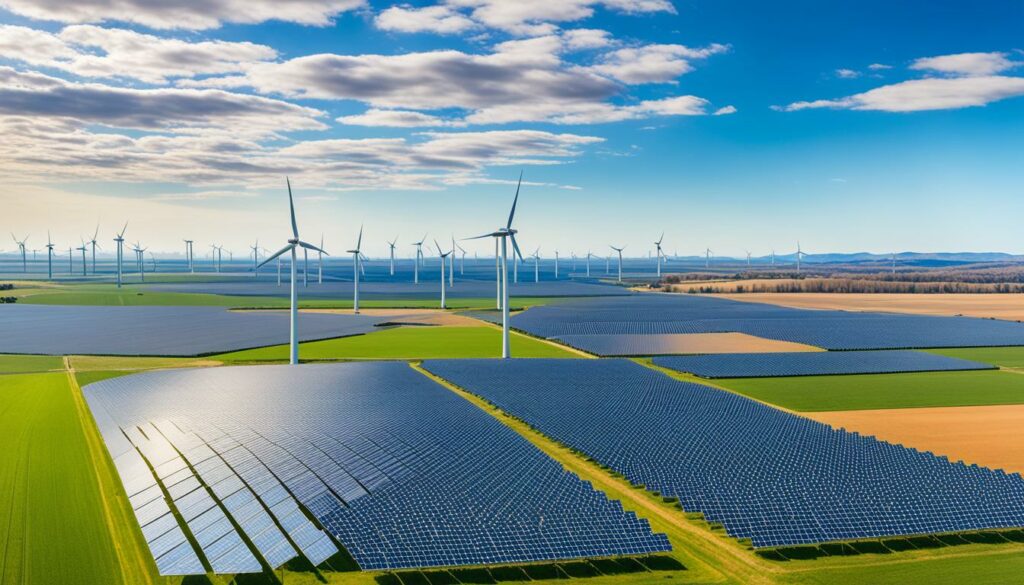
Farming is adopting more solar and wind energy. By 2024, wind power could grow 57% to 850 GW. Solar power is also becoming more popular, lowering farm electric bills. It’s expected to increase for homes and businesses.
The future of renewable farming relies greatly on new tech. This includes better energy storage and more efficient solar systems. There’s also a push for alternatives like biodiesel and ethanol. An example is Lanzajet and the U.S. making green aviation fuel from ethanol.
Rules and policies are key to the future of green farming. The Inflation Reduction Act ups funds for the Rural Energy for America Program (REAP). The USDA also supports making biofuels in a better way. Plus, the ITC cuts federal taxes by 30% on solar systems. This helps more farms go green.
Green energy farming clearly has a positive effect on the economy. Farmers save money on energy costs. They also earn extra through tax benefits and support schemes.
Farming with solar power cuts down on bills. The Investment Tax Credit (ITC) lessens spending by 30%. This makes setting up solar power systems more budget-friendly.
The Agriculture Energy Efficiency Rebate Program gives back money for green projects. This saves farmers even more and is good for the planet.
The Rural Energy for America Program (REAP) helps with grants up to half the cost. Plus, you can get a loan to cover three-quarters. This makes shifting to green energy easier for farmers.
Renewable energy boosts the economy. By 2020, wind energy might create 80,000 jobs and $1.2 billion in income. It offers landowners a fixed sum yearly for each turbine, if they have windy land.
Using more biomass energy could bring farmers and rural areas an extra $20 billion. Plus, it could cut down CO2 as much as taking 70 million cars off the road.
| Programme/Initiative | Type of Benefit | Impact |
|---|---|---|
| REAP | Grants and Loans | Up to 70% funding for green projects |
| ITC | Tax Credit | 30% less on solar set-up costs |
| Agriculture Energy Efficiency Rebate Program | Rebates | Helps with the costs of green projects |
| Bioenergy Program for Advanced Biofuels | Incentives | Promotes eco-friendly biofuel production |
All these efforts work together to make green farming more rewarding. They boost our economy and lead to a brighter future where farming is both sustainable and prosperous.
Renewable energy farming brings about many environmental benefits. It makes a big difference to our climate and the world around us. Moving to sustainable energy solutions helps reduce the harm caused by traditional energy.
Switching to renewable energy in farming is key to cutting down on greenhouse gases. In the US, making electricity from fossil fuels adds a lot to global warming. Natural gas and coal are the main culprits, throwing out a lot of CO2. On the other hand, renewable sources like wind, sun, and water produce way less CO2 for the same amount of power.
A study by the NREL suggests that renewable energy could slash power sector emissions by around 81% by 2050. Programmes like reaching 25% renewable energy by 2025 could ditch 277 million tons of CO2 each year. That’s like stopping the emissions from 70 coal plants. These examples show how important eco-friendly farming techniques are in fighting climate change.
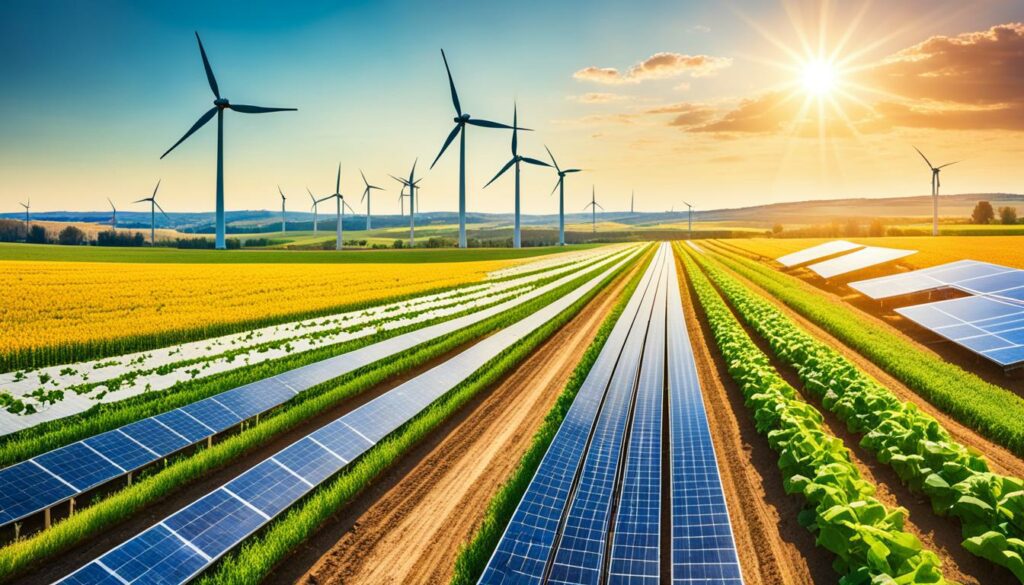
Renewable energy farming helps boost biodiversity. This is a huge deal for eco-friendly farming techniques. Solar farms, for example, can be placed to work well with local nature. This lets the plants and animals in the area grow and thrive.
Using renewable energy in farming fits with wider goals for being greener. Bioenergy projects, backed by the USDA, encourage making biofuels in a way that’s kind to nature. This limits pollution in water from farms, helping local plants and animals. Programs like EQIP’s On-Farm Energy Initiative also help farmers use energy smarter. This not only cuts emissions but also makes natural habitats better for wildlife.
All in all, renewable energy farming clearly offers sustainable energy solutions. These solutions are crucial for reaching our goals for the environment. Moving this way means we aren’t just solving our energy needs. We’re taking a smart step to save and improve our natural world and fight the impact of climate change.
Renewable energy farming has a bright future, but it faces many obstacles. Financial issues, technological hurdles, and social or cultural barriers are at the forefront. These challenges stop the widespread use of renewable energy in farming.
Not having enough money is a big problem for people wanting to invest in new energy solutions for farms. Even though investments have grown from $50 billion in 2005 to $70 billion in 2006, it’s still not enough. Especially in poorer countries, very little energy comes from renewable sources. Making the switch to renewable energy is expensive, especially for small farmers. For example, a shortage of wind turbine parts has made each kilowatt more expensive, from $1,100 to $1,500.
Getting past technological hurdles is crucial for renewable energy farming. Setting up and using these techs needs skilled workers. However, there are not enough of these skilled people in some areas. Also, many people don’t like renewable power projects because they worry about how they look and their impact on nature. It’s also tough to mix new technology with old systems. This is why countries like China, with lots of sun, are slow to use solar energy.
Changing minds and cultures is hard, and it also affects the move to renewable energy farming. Many people don’t know enough about the good sides of renewable energy. Also, some are too used to the old ways of farming and don’t want to try new things. Adding to this, laws can stand in the way. Just to mention, in 2005 only 55 countries supported renewable energy, but in 2013, this went up to 144. To get past these issues, it takes work from leaders, experts, and all those that this influences.
Bringing renewable energy into urban agriculture has a lot of perks. It helps farmers be more self-reliant and cuts down on the bad effects they have on the environment. This method fits right into the idea of doing farming in a way that is good for the Earth. It also helps tackle problems unique to farming in cities, like not having much space and needing a lot of energy.
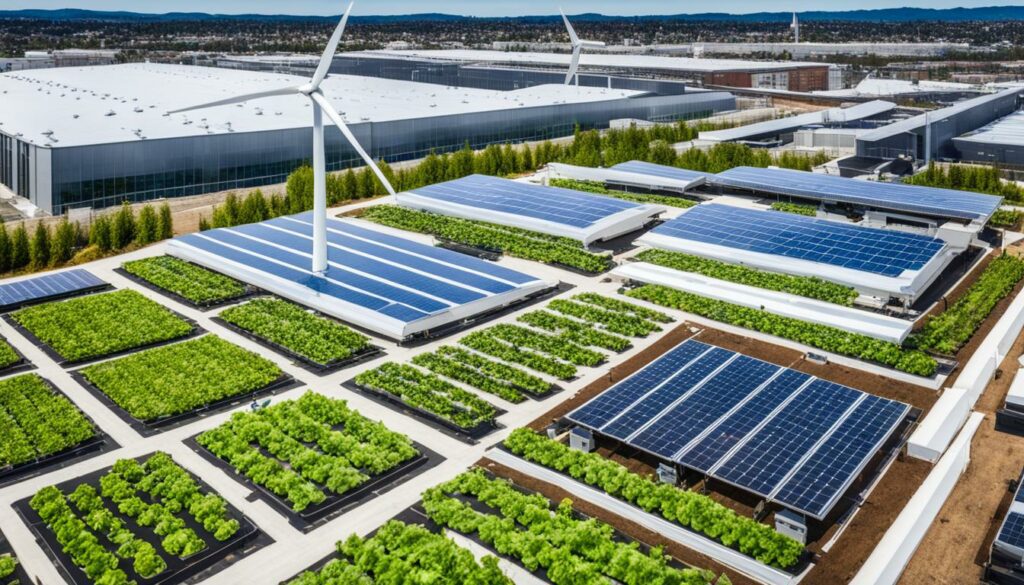
For those working the land in cities, using renewable energy can be a game-changer. Things like solar panels and wind turbines mean lower bills and not having to rely on energy sources that are going away. They also make sure there’s always power, which is super important for growing crops smoothly and keeping things running when the power is down.
What’s more, these systems help cut costs and stand up better to energy prices going up and down. Often, policies are in place to encourage this kind of farming, making it even more doable and tempting.
Many city projects show how well renewable energy and farming can work together. Like, there are rooftop gardens with solar panels that both grow food and make electricity. Then, you have vertical farms that use the wind and sun to meet their high energy demands.
Putting solar power in farms in the city can cut both energy bills and the planet-warming chemicals that comes from burning traditional energy. These smart-energy urban farms don’t just make sure we have enough food. They are a key part of making cities more sustainable places to live.
These projects are a great way to show how we can use the sun to power farming in the city. They not only make farming stronger but also easier on the world around us. Mixing solar power and city farming can even lead to more jobs and a boost in money for everyone involved.
The future of renewable energy farming is key to tackling major global issues like climate change and food security. Wind and solar power are set to grow significantly in 2024. This growth is expected to make them more significant than coal for generating electricity in the United States.
In recent times, the installation of solar panels on farms, known as agrivoltaic projects, has boomed. There are now 477 projects in the U.S., with almost 7.2 gigawatts of solar power. Over 150 new projects have started in the last nine months. This shows how vital renewable energy is for the future.
About a third of America’s methane emissions come from livestock farming. To cut these emissions, more farmers are using anaerobic digesters. These devices were at their most popular in 2021, according to USDA reports.
Farmers are also turning to renewable diesel due to its high demand. Prices for soybeans, used for making this diesel, are climbing. This shift in the market is making farmers plant more soybeans than corn, linking agriculture to the renewable energy sector.
The way we produce food contributes a lot to greenhouse gas emissions. By 2050, we’ll need to feed 10 billion people. To meet this huge demand sustainably, using renewable energy in farming is crucial. Technologies like solar panels can make farms more efficient with their water use.
Agrivoltaic farming, mixing agriculture with solar energy, is benefiting farmers. For example, it’s improving sheep wool and helping biodiversity. Geothermal systems and biogas are also proving useful. They help with farm temperature control and offer cheaper ways to heat farms.
Research from Oregon shows solar panels can make areas around them over 300% more water-efficient. In the EU, adopting climate-smart farming could lower emissions significantly by 2030. It could also boost farmers’ incomes by billions of dollars each year.
Finally, moving to renewable energy is all about building a flexible, tough, and varied energy network. This network should fight climate change, keep our food supply steady, and support farmers. Making renewable energy more common in farming is a key part of our sustainable future.
The future of renewable energy farming looks bright, with big steps forward. We’re moving towards a greener and more efficient way of farming. By 2024, we should see a 50% increase in renewable energy capacity. This is mostly because of solar energy, showing how much importance we’re placing on green energy.
Right now, 26% of the world’s electricity comes from renewable sources. This is expected to grow to 30% by 2024. The use of solar energy is particularly impressive. It is expected to grow by 600 GW. This is almost the same as Japan’s total electricity capacity. It shows just how much we rely on renewable energy now.
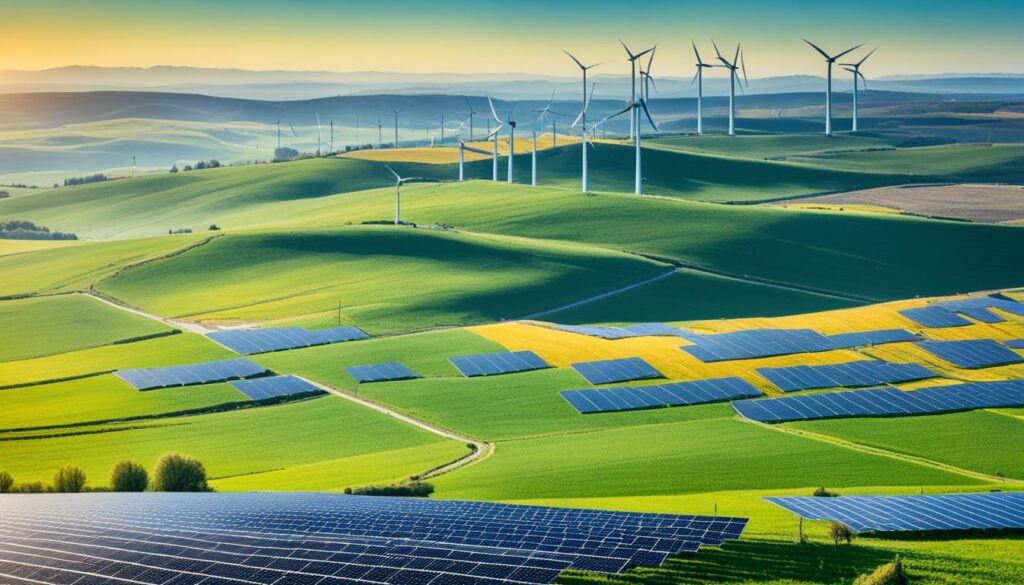
Using the power of the sun, the cost of solar energy has dropped 13% in 2018. In comparison, 72% of coal-generated electricity might not be cost-effective by 2040. These are big reasons to switch to renewable energy, especially for farms. The amount of solar power used at home is expected to rise from 58 GW in 2018 to 142 GW by 2024. In the business world, solar power could see a jump to 377 GW by 2024, showing an even faster increase.
The growth isn’t just in solar power. Wind energy is also growing fast. By 2024, onshore wind power could almost double to 850 GW. Offshore wind power might triple, reaching 65 GW. Water power, or hydropower, will see a 9% increase thanks to work in China, India, and Brazil. Geothermal energy is also picking up, with Asia helping it reach 18 GW by 2024. The US sees a big future for geothermal heat pumps too, with the market expected to be over $2 billion by 2024.
These figures show how much renewable energy can change the way we farm for the better. It’s key for making farming more sustainable, which is good for the environment and the economy. With more green energy, we can farm in ways that are better for us and for future generations.
The benefits of renewable energy farming are now clear to see. This makes renewable energy farming advocacy critical. It helps to make farming both cleaner and more sustainable. For example, wind energy is expected to create 80,000 new jobs by 2020. It will also bring $1.2 billion in new income to farmers and rural people. These numbers show how important renewable energy is for the economy.
Local actions and grassroots efforts are key to making renewable energy popular. Farming communities can earn extra money from wind turbines on their land. They get payments between $2,000 and $5,000 per turbine each year. Also, if the U.S. triples its use of biomass energy, it could mean up to $20 billion in new income. This shows how renewable energy can benefit farmers and rural areas in many ways.
Teaching and involving the community are vital to support sustainable farming. Solar energy, known for being cost-effective, highlights the need for broad advocacy work. The 2002 Farm Bill also offers millions of dollars in help for starting renewable energy projects. This support speeds up the move to better farming practices.
To make farming truly good for the environment, we must act on climate change. This needs new ideas and to include everyone. Groups that push for change, local efforts, and teaching are crucial. They help make policies that support renewable energy in farming. Together, we can ensure renewable energy is a key part of farming’s future.
Renewable energy farming uses sources like solar, wind, and water power to help farms. This lessens the harm to our planet. It also secures the food and energy we need.
Renewable energy farming is key to cutting down on oil and gas. It lessens harm to the Earth and keeps farming going. By using clean energy, we fight climate change and make our energy supply safer.
Solar panels, wind turbines, and water power systems are key. They cut how much harm we do and make farming greener.
Across the world, farms are using more renewable energy. Countries like the US, UK, and Australia lead with solar power. Help from governments and cheaper tech are speeding this up.
Big players include supportive governments and tech experts. China stands out for using solar power at home.
By placing solar panels on roofs, installing wind turbines, and using water power where possible. These steps make farms more green and efficient.
California made it a rule for new buildings to have solar power. And Japan invested in wind farms after a big disaster. These show a bright future for renewable farming.
Solar, wind, and water power are the main ones. Solar is easy and doesn’t cost as much. Wind and water power need the right places.
Now, solar power plants work better and store more energy. They also cost less to put in. These changes help solar farming a lot.
Wind farms deal with fitting into power grids, finding money and liking from people. Fixing these issues will fully use wind power in farming.
Water power is good for farming, mainly where water use is high. Although it costs a lot and can harm the environment, countries like China, India, and Brazil are still growing in this area.
The International Energy Agency sees big growth ahead. They expect a lot more solar panels soon. Good rules and new tech are making this happen.
It saves money for farmers by cutting their energy bills. It also makes more jobs and helps the economy grow. This is all thanks to more money going into green energy.
Renewable farming lowers air pollution a lot and helps wildlife. It fights climate change and makes farming more sustainable.
Money problems, tech issues, and not everyone liking it are hard to overcome. Fixing these needs everyone, from the government to people in the field, to work together.
Putting solar panels on roofs and growing food in small, indoor farms help. These steps make cities self-reliant and cleaner, supporting green living.